-
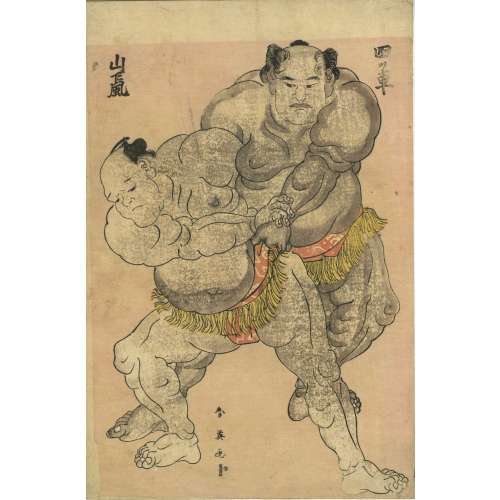 Katsukawa Shun'ei. The Sumo Bout between Yotsuguruma (right) and Yamaoroshi (left). Date: 1800 or 1805/06. Similar sheet can be found at Edo Tokyo Museum. Size: Vertical Ōban. Sumo wrestler Yotsuguruma Daihachi (1772 - 1809) first appeared in the records of national tournaments in winter of 1794. Then he lost 3 matches and won zero. He first won in the spring tournament of 1797 in a match against maegashira (the fifth-highest rank of sumo wrestlers) named Kougamine. Yamaoroshi Gengo (born 1762) came in at the winter tournament of 1799 . He was much more successful in his career than Yotsuguruma, but he had never won a tournament. It was the time of great Raiden, who won most of them. In the spring tournament of 1800 Yotsuguruma and Yamaoroshi fought against each other for the first time. Yotsuguruma lost. The next time they met on the ring was at the winter tournament of 1805, and again in 1806. Both matches were won by Yamaoroshi. Yamaoroshi retired in 1809; Yotsuguruma died in 1809.
Katsukawa Shun'ei. The Sumo Bout between Yotsuguruma (right) and Yamaoroshi (left). Date: 1800 or 1805/06. Similar sheet can be found at Edo Tokyo Museum. Size: Vertical Ōban. Sumo wrestler Yotsuguruma Daihachi (1772 - 1809) first appeared in the records of national tournaments in winter of 1794. Then he lost 3 matches and won zero. He first won in the spring tournament of 1797 in a match against maegashira (the fifth-highest rank of sumo wrestlers) named Kougamine. Yamaoroshi Gengo (born 1762) came in at the winter tournament of 1799 . He was much more successful in his career than Yotsuguruma, but he had never won a tournament. It was the time of great Raiden, who won most of them. In the spring tournament of 1800 Yotsuguruma and Yamaoroshi fought against each other for the first time. Yotsuguruma lost. The next time they met on the ring was at the winter tournament of 1805, and again in 1806. Both matches were won by Yamaoroshi. Yamaoroshi retired in 1809; Yotsuguruma died in 1809. -
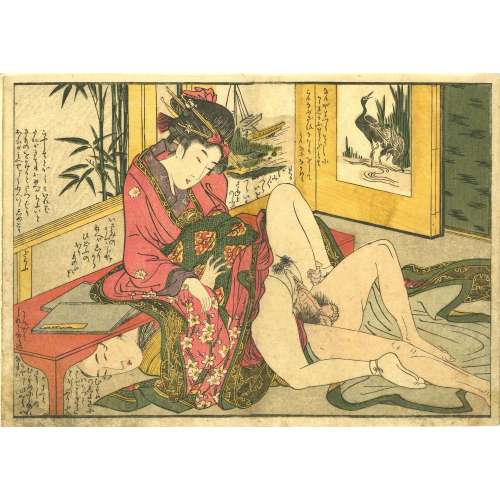 Kitagawa Utamaro. Illustration from book Ehon koi no Onamaki, published in 1799. Reference found by Chris Uhlenbeck: he found one of the designs in Hayashi Yoshikazu's 20-volume set Edo makura-e shi shusei: Kitagawa Utamaro. Size: Chuban (25.5 x 18.5 cm), two book pages glued together.
Kitagawa Utamaro. Illustration from book Ehon koi no Onamaki, published in 1799. Reference found by Chris Uhlenbeck: he found one of the designs in Hayashi Yoshikazu's 20-volume set Edo makura-e shi shusei: Kitagawa Utamaro. Size: Chuban (25.5 x 18.5 cm), two book pages glued together. -
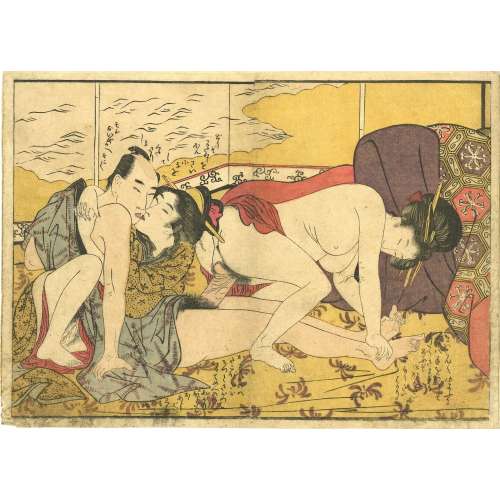 Kitagawa Utamaro. Illustration from the book Ehon koi no Onamaki. Cited at Hayashi Yoshikazu's 20-volume set Edo makura-e shi shusei: Kitagawa Utamaro. Size: Chuban (25.5 x 18.5 cm), two book pages glued together.
Kitagawa Utamaro. Illustration from the book Ehon koi no Onamaki. Cited at Hayashi Yoshikazu's 20-volume set Edo makura-e shi shusei: Kitagawa Utamaro. Size: Chuban (25.5 x 18.5 cm), two book pages glued together. -
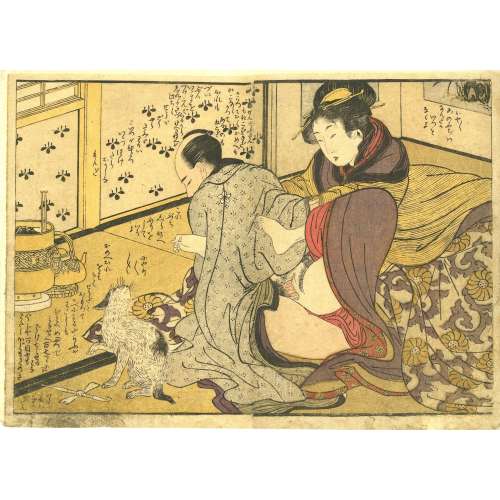 Kitagawa Utamaro. According to Chris Uhlenberg this is an illustration from the book Ehon koi no Onamaki, 3 vols, published in Kansei 11 (1799). Illustrated in b/w in: Hayashi Yoshikazu: Kitagawa Utamaro, in the series: Edo makura-e shi shusei, published in 1990, reissued 1994. Size: Chuban (25.5 x 18.5 cm), two book pages glued together.
Kitagawa Utamaro. According to Chris Uhlenberg this is an illustration from the book Ehon koi no Onamaki, 3 vols, published in Kansei 11 (1799). Illustrated in b/w in: Hayashi Yoshikazu: Kitagawa Utamaro, in the series: Edo makura-e shi shusei, published in 1990, reissued 1994. Size: Chuban (25.5 x 18.5 cm), two book pages glued together. -
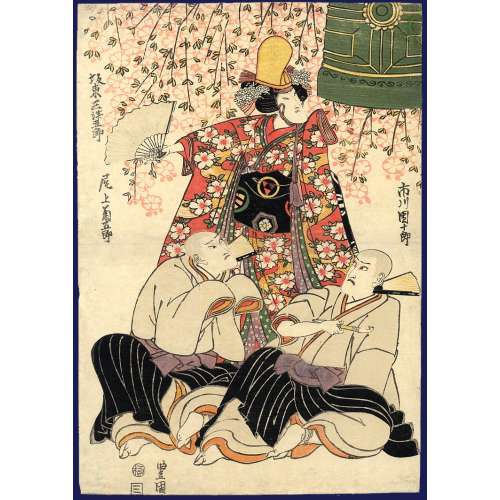 Artist: Utagawa Toyokuni I (1769–1825) Title: Actors Bando Mitsugorō, Ichikawa Danjūrō, Onoe Kikugorō in play The Maiden at Dōjō Temple. Presumably Bunka 13 (1816) at Nakamura Theater in Edo. Publisher: Mikawaya Seiemon (c. 1805-1829); Marks' "Publishers" № 328, p. 235. Size: Vertical ôban MEDIUM OR TECHNIQUE: Woodblock print (nishiki-e); ink and color on paper. Signed: Toyokuni ga Censor's seal: kiwame Detailed discussion on the topic can be seen at: The Maiden at Dōjō Temple
Artist: Utagawa Toyokuni I (1769–1825) Title: Actors Bando Mitsugorō, Ichikawa Danjūrō, Onoe Kikugorō in play The Maiden at Dōjō Temple. Presumably Bunka 13 (1816) at Nakamura Theater in Edo. Publisher: Mikawaya Seiemon (c. 1805-1829); Marks' "Publishers" № 328, p. 235. Size: Vertical ôban MEDIUM OR TECHNIQUE: Woodblock print (nishiki-e); ink and color on paper. Signed: Toyokuni ga Censor's seal: kiwame Detailed discussion on the topic can be seen at: The Maiden at Dōjō Temple -
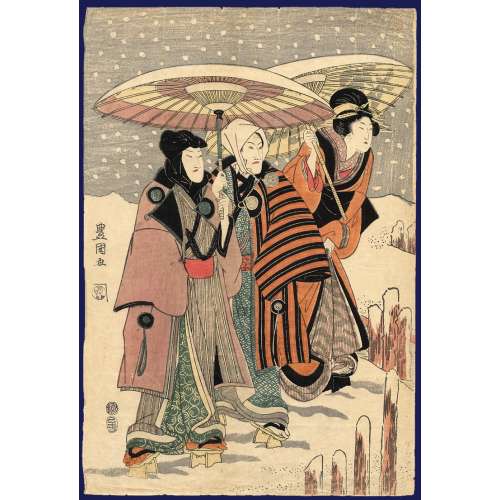 Similar image at MFA under title: Actors and Women in the Snow MFA ACCESSION NUMBER: 11.13568 Date: 1809 (Bunka 6), 12th month Artist: Utagawa Toyokuni I (1769–1825) Publisher Tsuruya Kinsuke (firm name Sôkakudô), № 554 in Marks's "Publishers". DIMENSIONS: Vertical ôban; 38.2 x 25.8 cm (15 1/16 x 10 3/16 in.) MEDIUM OR TECHNIQUE: Woodblock print (nishiki-e); ink and color on paper. Signed: Toyokuni ga (豊国画) Censor's seals: kiwame (改印:極) MFA assumes that this may be "one sheet of incomplete triptych?"
Similar image at MFA under title: Actors and Women in the Snow MFA ACCESSION NUMBER: 11.13568 Date: 1809 (Bunka 6), 12th month Artist: Utagawa Toyokuni I (1769–1825) Publisher Tsuruya Kinsuke (firm name Sôkakudô), № 554 in Marks's "Publishers". DIMENSIONS: Vertical ôban; 38.2 x 25.8 cm (15 1/16 x 10 3/16 in.) MEDIUM OR TECHNIQUE: Woodblock print (nishiki-e); ink and color on paper. Signed: Toyokuni ga (豊国画) Censor's seals: kiwame (改印:極) MFA assumes that this may be "one sheet of incomplete triptych?" -
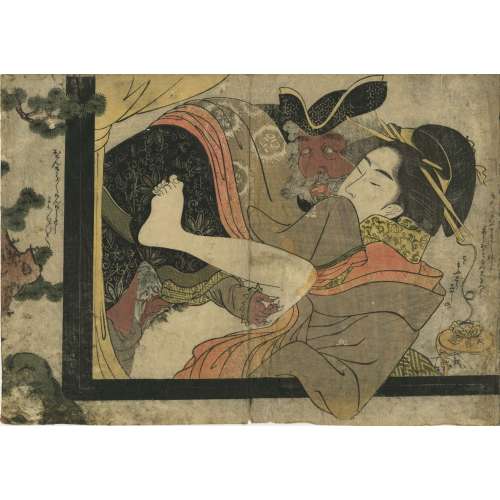 Woodblock print album of thirteen prints, ōban, nishiki-e. Artist: Chōkyōsai Eiri [鳥橋斎 栄里] (Japanese, fl. c. 1789 ~ 1801 ). Models of calligraphy (Fumi no kiyogaki), New Year 1801. This title is taken from Chris Uhlenbeck's Japanese Erotic Fantasies Sexual Imagery of the Edo Period. — Hotei Publishing, 2005, ISBN 90-74822-66-5):. A detailed description of the album can be found at The Complete Ukiyo-e Shunga №9 Eiri, 1996, ISBN 4-309-91019. Most of the edition is in Japanese, though Richard Lane writes a section in English: Eiri: Love-letters, Love Consummated: Fumi-no-kiyogaki. The article starts with the following statement: "Why all the fuss about Sharaku? Because he is so "mysterious"? No, not at all: because he is such a good artist. But Sharaku is not the only great yet enigmatic ukiyo-e artist and I propose to resurrect here one of his important contemporaries who has been all too long neglected: Chōkyōsai Eiri. As with many of the notable ukiyo-e masters, nothing is known of Eiri's biography. All we can say is what we learn from his extant prints and paintings: that he flourished during the second half of the Kansei Period [1789-1801]; and that he was a direct pupil of the great Eishi - who, being of eminent samurai stock, may well have attracted pupils of similar background." Another citation from Japanese Erotic Fantasies: "This album is one of the boldest sets of ōban-size shunga known, The first edition contains thirteen instead of the customary twelve designs". Here I present all thirteen prints, though the edition I bought in Kyoto in 2014 contained only twelve. The thirteenth print was purchased later in the United States (sheet №12).
Woodblock print album of thirteen prints, ōban, nishiki-e. Artist: Chōkyōsai Eiri [鳥橋斎 栄里] (Japanese, fl. c. 1789 ~ 1801 ). Models of calligraphy (Fumi no kiyogaki), New Year 1801. This title is taken from Chris Uhlenbeck's Japanese Erotic Fantasies Sexual Imagery of the Edo Period. — Hotei Publishing, 2005, ISBN 90-74822-66-5):. A detailed description of the album can be found at The Complete Ukiyo-e Shunga №9 Eiri, 1996, ISBN 4-309-91019. Most of the edition is in Japanese, though Richard Lane writes a section in English: Eiri: Love-letters, Love Consummated: Fumi-no-kiyogaki. The article starts with the following statement: "Why all the fuss about Sharaku? Because he is so "mysterious"? No, not at all: because he is such a good artist. But Sharaku is not the only great yet enigmatic ukiyo-e artist and I propose to resurrect here one of his important contemporaries who has been all too long neglected: Chōkyōsai Eiri. As with many of the notable ukiyo-e masters, nothing is known of Eiri's biography. All we can say is what we learn from his extant prints and paintings: that he flourished during the second half of the Kansei Period [1789-1801]; and that he was a direct pupil of the great Eishi - who, being of eminent samurai stock, may well have attracted pupils of similar background." Another citation from Japanese Erotic Fantasies: "This album is one of the boldest sets of ōban-size shunga known, The first edition contains thirteen instead of the customary twelve designs". Here I present all thirteen prints, though the edition I bought in Kyoto in 2014 contained only twelve. The thirteenth print was purchased later in the United States (sheet №12). №1: "...one of the most exotic scenes in all shunga. A Dutch kapitan is discovered coupling with a lovely Japanese courtesan, beside a large window opening upon a garden...".
№1: "...one of the most exotic scenes in all shunga. A Dutch kapitan is discovered coupling with a lovely Japanese courtesan, beside a large window opening upon a garden...".

 №2: "...a fair young harlot is seen masturbating with a grinding-pestle - a man watches intently from under bedding." [I have two specimens of this design; the one from album is more soiled but less faded].
№2: "...a fair young harlot is seen masturbating with a grinding-pestle - a man watches intently from under bedding." [I have two specimens of this design; the one from album is more soiled but less faded].
 №3: "...the artist has effectively contrasted the lovers by depicting the man's face as seen through the geisha's gauze skirt. [...] we are impressed more by strikingly elegant composition, the dramatic coloring, rather than feeling any great urge to participate in the energetic proceedings..."
№3: "...the artist has effectively contrasted the lovers by depicting the man's face as seen through the geisha's gauze skirt. [...] we are impressed more by strikingly elegant composition, the dramatic coloring, rather than feeling any great urge to participate in the energetic proceedings..."
 №4: "This scene is a most straightforward one, featuring the standard Missionary Position [capitalization by R. Lane].; but withal, the contrast of the young and naked, secret lover and the richly-clothed courtesan amid luxurious bedding..."
№4: "This scene is a most straightforward one, featuring the standard Missionary Position [capitalization by R. Lane].; but withal, the contrast of the young and naked, secret lover and the richly-clothed courtesan amid luxurious bedding..."
 №5: "In a striking lesbian scene (which has no equivalent in Utamaro, and is, incidentally, often omitted in later editions of this album), the girl at left prepares to receive the harikata (dildo) worn by the older girl at right (who holds a seashell containing lubricant)."
№5: "In a striking lesbian scene (which has no equivalent in Utamaro, and is, incidentally, often omitted in later editions of this album), the girl at left prepares to receive the harikata (dildo) worn by the older girl at right (who holds a seashell containing lubricant)."
 №6: "In the first appearance of a matronly heroine in this series, we find a widow - with shaven eyebrows and clipped hair - sporting with a handsome yound shop-clerk, mounting him with all her might."
№6: "In the first appearance of a matronly heroine in this series, we find a widow - with shaven eyebrows and clipped hair - sporting with a handsome yound shop-clerk, mounting him with all her might."

 №7: "... lady of samurai court: here, shown taking advantage of an official outing to temple and theatre, to rendezvous with a secret lover on a teahouse balcony." R. Lane considers this design the least successful in the series, especially in comparison with the same theme by Utamaro: "Utamaro female is almost ferocious in her lust for sexual gratification", which does not sound true to me. See Utamaro's sheet №5 from the album Utamakura (歌まくら, Poem of the Pillow) [courtesy The British Museum without permission]:
№7: "... lady of samurai court: here, shown taking advantage of an official outing to temple and theatre, to rendezvous with a secret lover on a teahouse balcony." R. Lane considers this design the least successful in the series, especially in comparison with the same theme by Utamaro: "Utamaro female is almost ferocious in her lust for sexual gratification", which does not sound true to me. See Utamaro's sheet №5 from the album Utamakura (歌まくら, Poem of the Pillow) [courtesy The British Museum without permission]:
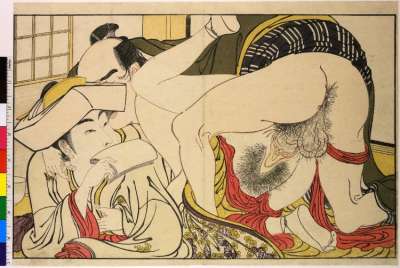 Then, as Richard Lane states, "we are flung suddenly to the bottom rung of Edo society":
Then, as Richard Lane states, "we are flung suddenly to the bottom rung of Edo society":
 №8: "Here we find a fair yotaka ('night-hawk', e.i. streetwalker) accommodating a lusty client in a lumberyard by the bank of the Sumida River".
№8: "Here we find a fair yotaka ('night-hawk', e.i. streetwalker) accommodating a lusty client in a lumberyard by the bank of the Sumida River".
 №9: '... a slightly plump harlot of the lower class receives a night visit from her lover, whose naked form she tries to cover with a cloak."
№9: '... a slightly plump harlot of the lower class receives a night visit from her lover, whose naked form she tries to cover with a cloak."
 №10: "...likely maidservant and lackey - are depicted in bath-room, their passions are all too obviously fired by steaming water."
№10: "...likely maidservant and lackey - are depicted in bath-room, their passions are all too obviously fired by steaming water."
 №11: "...this scene of courtesan and secret lover ranks high not only in Eiri's œuvre but also in the annals of the ukiyo-e genre itself. Both design and colouring are impeccable and, for this period, there is nothing even in the work of great Utamaro that really surpasses it." Again, a doubtful statement, however, this is Utamaro's design for the reader to judge:
№11: "...this scene of courtesan and secret lover ranks high not only in Eiri's œuvre but also in the annals of the ukiyo-e genre itself. Both design and colouring are impeccable and, for this period, there is nothing even in the work of great Utamaro that really surpasses it." Again, a doubtful statement, however, this is Utamaro's design for the reader to judge:
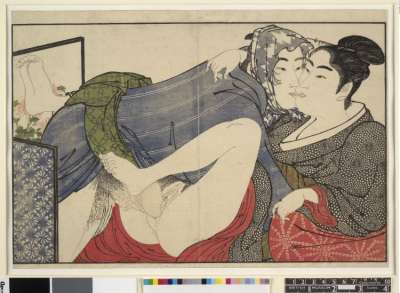 The last design in my album is this:
The last design in my album is this:
 #13: In most reference books it goes under number 13, and we will assign this number to the sheet. "The final scene of the album features naked participants, probably samurai man and wife. The print is rather subdued in tone and colour, if not in the degree of the passion displayed..."
An additional sheet, acquired separately from a reputable dealer in New York, is usually listed as №12:
#13: In most reference books it goes under number 13, and we will assign this number to the sheet. "The final scene of the album features naked participants, probably samurai man and wife. The print is rather subdued in tone and colour, if not in the degree of the passion displayed..."
An additional sheet, acquired separately from a reputable dealer in New York, is usually listed as №12:
 №12: "One might think that Eiri has reached his peak with the preceding plate 11 - and indeed he has, in both esthetic and erotic terms. But the album is not yet finished, and the next scene lends a needed variety to the series, a slightly comic tableau featuring a middle-aged lackey attempting to forcibly seduce a servant girl of the same domicile". Utamaro's design, that inspired Eiri is here:
№12: "One might think that Eiri has reached his peak with the preceding plate 11 - and indeed he has, in both esthetic and erotic terms. But the album is not yet finished, and the next scene lends a needed variety to the series, a slightly comic tableau featuring a middle-aged lackey attempting to forcibly seduce a servant girl of the same domicile". Utamaro's design, that inspired Eiri is here:
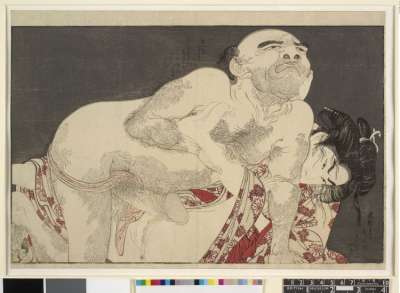 All descriptions are taken from Richard Lane's article at The Complete Ukiyo-e Shunga №9 Eiri, 1996. He concluded: "...Eiri's erotic series represents a major contribution to shunga art towards the close of ukiyo-e "Golden Age". In part inspired by Utamaro's classic album, this series withal constitutes a unified and original achievement, providing a cumulative effect of gracefully elegant yet glowing eroticism, which remains in the mind's eye long after the pictures themselves are far away."
I only would like to mention here that in several reference sources this album goes under name of Eisho; unfortunately, this mistake is reproduced at www.ukiyo-e.org, which miraculously shows exactly my print, but under the wrong name of the artist. The same mistake can be found at Shunga. The art of love in Japan. Tom and Mary Anne Evans. Paddington Press Ltd., 1975. ISBN 0-8467-0066-2; plates 6.74-6.77: Chōkyōsai Eishō, c. 1800. Even the British Museum edition of 2010 gives the same erroneous attribution: Chōkyōsai Eishō (1793-1801); they provide the following translation of title: "Clean Draft of a Letter" [see: Shunga. Erotic art in Japan. Rosina Buckland. The British Museum Press, 2010; pp. 110-112]. To the honour of the British Museum, I must admit that they have corrected themselves in Shunga. Sex and pleasure in Japanese art. Edited by Timothy Clark, et al. Hotei Publishing, 2013. Now, they say Chōkyōsai Eiri (worked c. 1790s-1801); they also provide a new title: "Neat Version of the Love Letter, or Pure Drawings of Female Beauty". I have already mentioned Richard Lane's version of title: "Love-letters, Love Consummated", and Chris Uhlenbeck's "Models of calligraphy". In poorly designed and printed Shunga. Erotic figures in Japanese art. Presented by Gabriele Mandel. Translated by Alison L'Eplattenier. Crescent Books, New York, 1983, the artist is named Shokyosai Eisho (beginning of the 19th century); title provided: "Models of Calligraphy". Correct attribution to Chōkyōsai Eiri also can be found at Poem of the pillow and other stories by Utamaro, Hokusai, Kuniyoshi and other artists of the floating world. Gian Carlo Calza in collaboration with Stefania Piotti. Phaidon Press, 2010; though the title is translated as "Clean Copy of Female Beauty".
All descriptions are taken from Richard Lane's article at The Complete Ukiyo-e Shunga №9 Eiri, 1996. He concluded: "...Eiri's erotic series represents a major contribution to shunga art towards the close of ukiyo-e "Golden Age". In part inspired by Utamaro's classic album, this series withal constitutes a unified and original achievement, providing a cumulative effect of gracefully elegant yet glowing eroticism, which remains in the mind's eye long after the pictures themselves are far away."
I only would like to mention here that in several reference sources this album goes under name of Eisho; unfortunately, this mistake is reproduced at www.ukiyo-e.org, which miraculously shows exactly my print, but under the wrong name of the artist. The same mistake can be found at Shunga. The art of love in Japan. Tom and Mary Anne Evans. Paddington Press Ltd., 1975. ISBN 0-8467-0066-2; plates 6.74-6.77: Chōkyōsai Eishō, c. 1800. Even the British Museum edition of 2010 gives the same erroneous attribution: Chōkyōsai Eishō (1793-1801); they provide the following translation of title: "Clean Draft of a Letter" [see: Shunga. Erotic art in Japan. Rosina Buckland. The British Museum Press, 2010; pp. 110-112]. To the honour of the British Museum, I must admit that they have corrected themselves in Shunga. Sex and pleasure in Japanese art. Edited by Timothy Clark, et al. Hotei Publishing, 2013. Now, they say Chōkyōsai Eiri (worked c. 1790s-1801); they also provide a new title: "Neat Version of the Love Letter, or Pure Drawings of Female Beauty". I have already mentioned Richard Lane's version of title: "Love-letters, Love Consummated", and Chris Uhlenbeck's "Models of calligraphy". In poorly designed and printed Shunga. Erotic figures in Japanese art. Presented by Gabriele Mandel. Translated by Alison L'Eplattenier. Crescent Books, New York, 1983, the artist is named Shokyosai Eisho (beginning of the 19th century); title provided: "Models of Calligraphy". Correct attribution to Chōkyōsai Eiri also can be found at Poem of the pillow and other stories by Utamaro, Hokusai, Kuniyoshi and other artists of the floating world. Gian Carlo Calza in collaboration with Stefania Piotti. Phaidon Press, 2010; though the title is translated as "Clean Copy of Female Beauty".
-
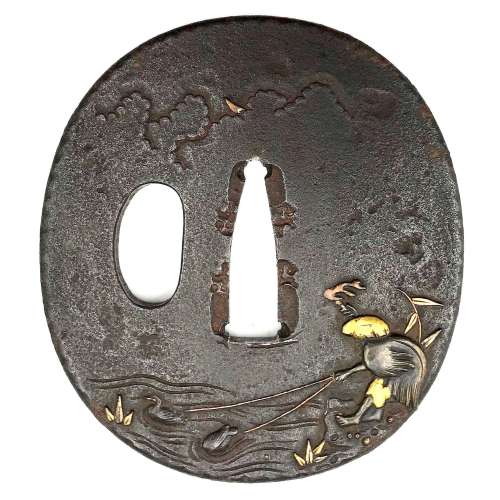 Iron tsuba of oval form carved and inlaid in gold and copper with cormorant fisherman in disguise. Unsigned. Dimensions: 67.7 mm x 61.5 mm x 3.8 mm (at seppa-dai) Edo period: 18th century. "Since Nara period, Japanese fishermen in small boats have used cormorants (u) to catch river fish at night, binding the necks of the birds so that the fish are not swallowed. [...] The bird and the work it performs are symbols of selfless devotion to one's master and keen eyesight." - from Merrily Baird. Symbols of Japan. Thematic motifs in art and design. Rizzoli international publications, Inc., 2001; p. 104. See also TSU-0212 and TSU-0096
Iron tsuba of oval form carved and inlaid in gold and copper with cormorant fisherman in disguise. Unsigned. Dimensions: 67.7 mm x 61.5 mm x 3.8 mm (at seppa-dai) Edo period: 18th century. "Since Nara period, Japanese fishermen in small boats have used cormorants (u) to catch river fish at night, binding the necks of the birds so that the fish are not swallowed. [...] The bird and the work it performs are symbols of selfless devotion to one's master and keen eyesight." - from Merrily Baird. Symbols of Japan. Thematic motifs in art and design. Rizzoli international publications, Inc., 2001; p. 104. See also TSU-0212 and TSU-0096 -
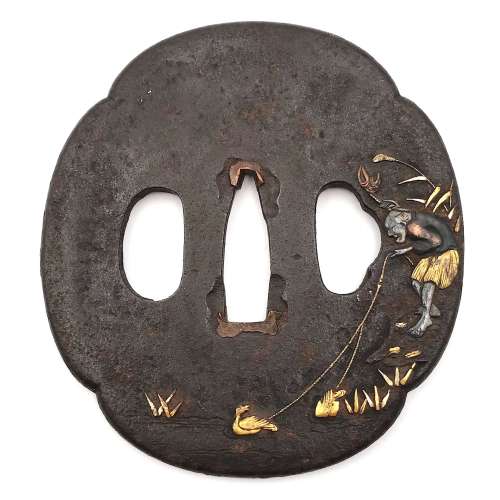 Mokkō form iron tsuba carved in relief and inlaid with soft metals (copper, gold, silver) with the design of a cormorant fisherman on the face and a boat on the reverse. Unsigned. Dimensions: 77 mm x 69 mm x 3.0 mm (at seppa-dai) Edo period: 18th or 19th century. "Since Nara period, Japanese fishermen in small boats have used cormorants (u) to catch river fish at night, binding the necks of the birds so that the fish are not swallowed. [...] The bird and the work it performs are symbols of selfless devotion to one's master and keen eyesight." - from Merrily Baird. Symbols of Japan. Thematic motifs in art and design. Rizzoli international publications, Inc., 2001; p. 104. See also in this collection TSU-0212 and TSU-0241.
Mokkō form iron tsuba carved in relief and inlaid with soft metals (copper, gold, silver) with the design of a cormorant fisherman on the face and a boat on the reverse. Unsigned. Dimensions: 77 mm x 69 mm x 3.0 mm (at seppa-dai) Edo period: 18th or 19th century. "Since Nara period, Japanese fishermen in small boats have used cormorants (u) to catch river fish at night, binding the necks of the birds so that the fish are not swallowed. [...] The bird and the work it performs are symbols of selfless devotion to one's master and keen eyesight." - from Merrily Baird. Symbols of Japan. Thematic motifs in art and design. Rizzoli international publications, Inc., 2001; p. 104. See also in this collection TSU-0212 and TSU-0241. -
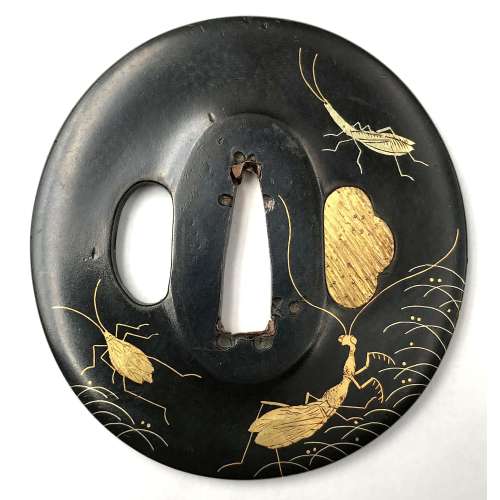 Shakudō tsuba of the slightly vertically elongated round form (nagamaru-gata) decorated by gold in flat inlay (hira-zōgan) with three insects (cricket, locust, and praying mantis), grass and dewdrops motif. Kogai hitsu-ana is plugged with gilded soft metal. Height: 70.2 mm; width: 66.4 mm x Thickness at seppa-dai: 4.5 mm. Edo period (from ca. 1700 to ca. 1850) Unsigned. Attributed to Kaga School or Murakami School. Almost identical tsuba (no dewdrops, though) is illustrated and described at page 60 of Kokusai Tosogu Kai. 7th International Convention & Exhibition, November 1st, 2011 at Tokyo National Museum, page 60. It is attributed to the Kaga School, Mid Edo period (Late 17th - early 18th century). Dimensions: 70.5 x 66 x 4.5 mm. "The rich black shakudo plate has been slightly lowered (dished out) and then polished. Gold insects crawl amongst grasses, depicted by Kaga style hirazogan (flat inlay). One tendril of the mantis overlaps onto seppa-dai. The mantis boldly looks out from the tsuba in a curious way. This style of Kaga tsuba was popular during the Genroku era (1688-1703)."Another source is Japanese Sword Fittings. A descriptive catalogue of the Collection of G.H. Naunton, Esq., completed and illustrated by Henri L. Joly, - 1912:
Shakudō tsuba of the slightly vertically elongated round form (nagamaru-gata) decorated by gold in flat inlay (hira-zōgan) with three insects (cricket, locust, and praying mantis), grass and dewdrops motif. Kogai hitsu-ana is plugged with gilded soft metal. Height: 70.2 mm; width: 66.4 mm x Thickness at seppa-dai: 4.5 mm. Edo period (from ca. 1700 to ca. 1850) Unsigned. Attributed to Kaga School or Murakami School. Almost identical tsuba (no dewdrops, though) is illustrated and described at page 60 of Kokusai Tosogu Kai. 7th International Convention & Exhibition, November 1st, 2011 at Tokyo National Museum, page 60. It is attributed to the Kaga School, Mid Edo period (Late 17th - early 18th century). Dimensions: 70.5 x 66 x 4.5 mm. "The rich black shakudo plate has been slightly lowered (dished out) and then polished. Gold insects crawl amongst grasses, depicted by Kaga style hirazogan (flat inlay). One tendril of the mantis overlaps onto seppa-dai. The mantis boldly looks out from the tsuba in a curious way. This style of Kaga tsuba was popular during the Genroku era (1688-1703)."Another source is Japanese Sword Fittings. A descriptive catalogue of the Collection of G.H. Naunton, Esq., completed and illustrated by Henri L. Joly, - 1912: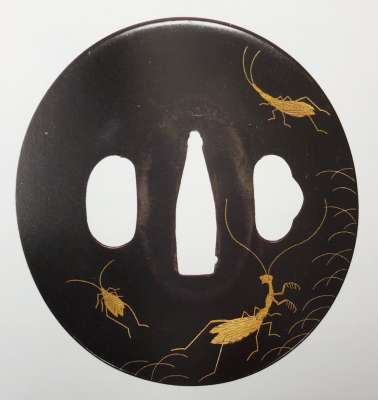
7-U17. Ron Hartmann Collection.
Kanazawa in Kaga was a centre of fine metal work during the whole of the Tokugawa period. At first the inlayers of Fushimi following the Daimyo Maeda went to Kanazawa, then some of the Gotō masters proceeded from Kyoto for short periods to work for the Daimyo, so that their influence was strongly impressed upon Kaga work..." A somewhat look-a-like tsuba is illustrated at plate XXVIII, Kaga Inlay, №653 with the following description at page 52: "Shakudō, inlaid with five insects in gold: crickets, praying mantis, grasshopper, in the style of Takagawara Ujitsugu.
According to M. Sesko, Ujitsugu was a master from Katsuki and Kaneko School in Kaga, son of Ujihira. Ujihira's father Ujiyoshi died in 1802. This brings us to the mid-19th century, instead of mid-18th or earlier. On the other hand, a very much look alike specimen at MFA collection (ACCESSION NUMBER 17.1061) has the with the following description: Edo period. Late 18th–early 19th century. Murakami School. Main material: shakudo; other metals: gold; decorative technique: iroe hirazogan.A detailed account of Murakami school can be found at The Japanese toso-kinko Schools.// Lulu Inc., 2012 by Markus Sesko, on pages 235-239. All-in-all, it's either Kaga School or Murakami School, either ca. 1700 or ca. 1850. Quite a range! SOLD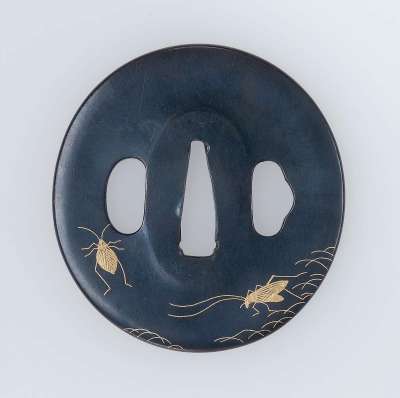
MFA # 17.1061
-
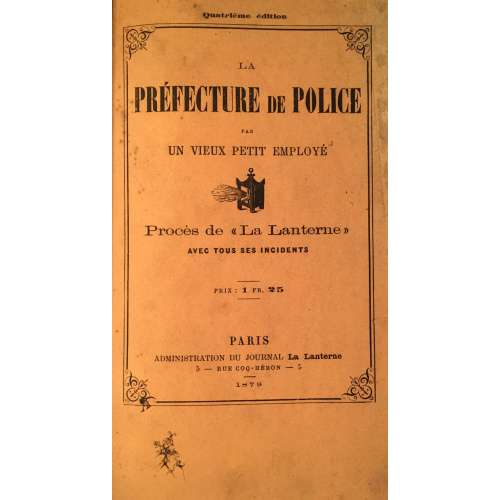
La Préfecture de Police, par un vieux petit employé - Procès de La Lanterne avec tous ses incidents. Administration du journal La Lanterne, Paris, 1879.
Quatrième édition.
Anonymous publication. Authorship attributed to: Yves Guyot, Francisque Sarcey. Source: Harvard College Library, Soc. 3375.6, 14-OCT-1914, Wolcott Fund.
-
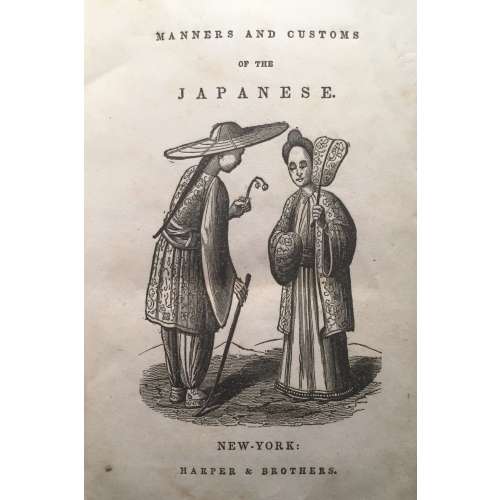
Manners and Customs of the Japanese, in the Nineteenth Century. From the Accounts of Recent Dutch Residents in Japan, and from the German Work of Dr. Ph. Fr. von Siebold.
Author: Siebold, Philipp Franz von et al.
Publisher: Harper & Brothers, New York, 1841.
-
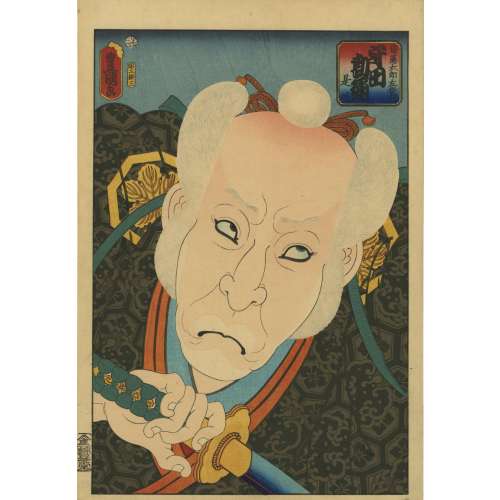 Artist: Utagawa Kunisada [歌川 国貞] a.k.a. Utagawa Toyokuni III [三代歌川豊国] (Japanese, 1786 – 1865). Block cutter: Horikō (Kiyomizu) Ryūzō [彫工 柳三]. Publisher: Ebisuya Shoshichi [恵比寿屋庄七], Kinshōdō (Japanese, fl. c. 1846 – 1883). Actor Morita Kan'ya XI as Saito Tarozaemon Toshiyuki (Morito Kan'ya, Saito Tarozaemon Toshiyuki) Signed Toyokuni ga within the artist's Toshidama cartouche, publisher's seal Sho, Kinshodo, carver's seal Horiko Ryusan, censor's seal aratame with date 1860, 3rd month. Date: 3/1860. Oban tate-e; 36.5 x 25.3 cm. The actor Morita Kan'ya XI (1802-1863) is in the role of Saito Tarozaemon Toshiyuki from the play Oto no Miya Asahi no Yoroi (Oto no Miyo and the Armor of the Rising Sun). The play picks up following the Genko War of 1331-33 in which Emperor Go-Daigo (1288-1339) led a failed uprising against the ruling Hojo clan. Tarozaemon was a Hojo warlord and is credited with much of the victory. After the conflict, his lord Norisada receives a summer festival lantern from the courtesan Sanmi-no-Tsubone, which bears a riddling inscription. He and Tarozaemon deliberate over the courtesan and her message for quite some time until they realize that she is attempting to manipulate Norisada in the hopes of returning the Emperor from exile. Following this revelation, Norisada reinterprets the message to mean kiriko, literally "to cut a child," and determines that Sanmi-no-Tsubone's son must be killed. He instructs Tarozaemon to do the deed. However, unbeknownst to Norisada and in spite of his allegiance to the Hojo clan, Tarozaemon is sympathetic to Sanmi-no-Tsubone and her son. At one time, his own daughter had served in the Imperial Palace and was spared execution only through Sanmi-no-Tsubone's intervention. As repayment of that debt, he kills his own grandson in the other boy's stead and returns to Norisada to report that he had accomplished the mission. This print is from a series of portraits that Kunisada undertook very late in life and has been named Kinshodo-ban yakusha okubi-e (Kinshodo's Large-Head Actor Portraits) in reference to the publisher, Ebisuya Shochochi of Kinshodo. The series depicted great actors from the past and present in their famous roles. Kunisada was guided by images from his own oeuvre: he recorded Kan'ya in this role in the 8th month of 1829. As this was meant to be Kunisada's grandest actor series, it was executed on thick paper with the best possible pigments and the highest level of craftsmanship. In this unusual frontal portrait, Kunisada presents Morita Kan'ya XI as the loyal Tarozaemon with his eyes rolling upward and his jaw set in grim determination to commit the unthinkable act in an ultimate display of samurai honour. Text by Scholten Japanese Art, New York. Ref.: Waseda University Theatre Museum (enpaku.waseda.ac.jp), accession no. 100-5261 (for 1829 portrait of the same); [LIB-1212.2017] Robert Schaap. Kunisada: Imaging, drama and beauty. — Leiden: Hotei Publishing, 2016, p. 165 (№ 16). Andreas Marks. Publishers of Japanese woodblock prints: A compendium. Ebisuya Shoshichi (1846-83) - P6032.
Artist: Utagawa Kunisada [歌川 国貞] a.k.a. Utagawa Toyokuni III [三代歌川豊国] (Japanese, 1786 – 1865). Block cutter: Horikō (Kiyomizu) Ryūzō [彫工 柳三]. Publisher: Ebisuya Shoshichi [恵比寿屋庄七], Kinshōdō (Japanese, fl. c. 1846 – 1883). Actor Morita Kan'ya XI as Saito Tarozaemon Toshiyuki (Morito Kan'ya, Saito Tarozaemon Toshiyuki) Signed Toyokuni ga within the artist's Toshidama cartouche, publisher's seal Sho, Kinshodo, carver's seal Horiko Ryusan, censor's seal aratame with date 1860, 3rd month. Date: 3/1860. Oban tate-e; 36.5 x 25.3 cm. The actor Morita Kan'ya XI (1802-1863) is in the role of Saito Tarozaemon Toshiyuki from the play Oto no Miya Asahi no Yoroi (Oto no Miyo and the Armor of the Rising Sun). The play picks up following the Genko War of 1331-33 in which Emperor Go-Daigo (1288-1339) led a failed uprising against the ruling Hojo clan. Tarozaemon was a Hojo warlord and is credited with much of the victory. After the conflict, his lord Norisada receives a summer festival lantern from the courtesan Sanmi-no-Tsubone, which bears a riddling inscription. He and Tarozaemon deliberate over the courtesan and her message for quite some time until they realize that she is attempting to manipulate Norisada in the hopes of returning the Emperor from exile. Following this revelation, Norisada reinterprets the message to mean kiriko, literally "to cut a child," and determines that Sanmi-no-Tsubone's son must be killed. He instructs Tarozaemon to do the deed. However, unbeknownst to Norisada and in spite of his allegiance to the Hojo clan, Tarozaemon is sympathetic to Sanmi-no-Tsubone and her son. At one time, his own daughter had served in the Imperial Palace and was spared execution only through Sanmi-no-Tsubone's intervention. As repayment of that debt, he kills his own grandson in the other boy's stead and returns to Norisada to report that he had accomplished the mission. This print is from a series of portraits that Kunisada undertook very late in life and has been named Kinshodo-ban yakusha okubi-e (Kinshodo's Large-Head Actor Portraits) in reference to the publisher, Ebisuya Shochochi of Kinshodo. The series depicted great actors from the past and present in their famous roles. Kunisada was guided by images from his own oeuvre: he recorded Kan'ya in this role in the 8th month of 1829. As this was meant to be Kunisada's grandest actor series, it was executed on thick paper with the best possible pigments and the highest level of craftsmanship. In this unusual frontal portrait, Kunisada presents Morita Kan'ya XI as the loyal Tarozaemon with his eyes rolling upward and his jaw set in grim determination to commit the unthinkable act in an ultimate display of samurai honour. Text by Scholten Japanese Art, New York. Ref.: Waseda University Theatre Museum (enpaku.waseda.ac.jp), accession no. 100-5261 (for 1829 portrait of the same); [LIB-1212.2017] Robert Schaap. Kunisada: Imaging, drama and beauty. — Leiden: Hotei Publishing, 2016, p. 165 (№ 16). Andreas Marks. Publishers of Japanese woodblock prints: A compendium. Ebisuya Shoshichi (1846-83) - P6032. -
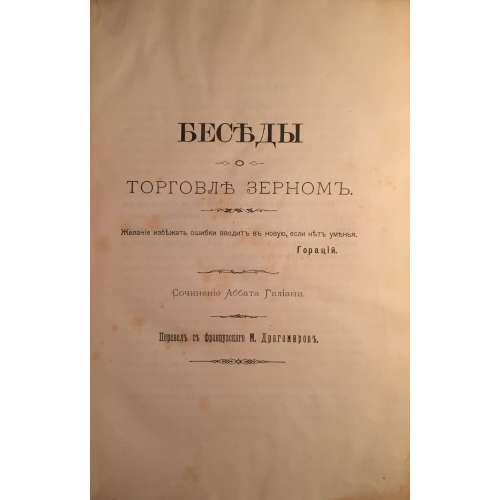
Беседы о торговле зерном. Сочинение аббата Галиани. Перевел с французского М. Драгомиров. — [Киев]: [тип. Окр. Штаба], [1891]. — [4], III, [3], 210, XXII стр. Примечание: Доб. тит. л. на фр. яз.: Dialogues sur le commerce des bleds. — A Londres, MDCCLXX.
-
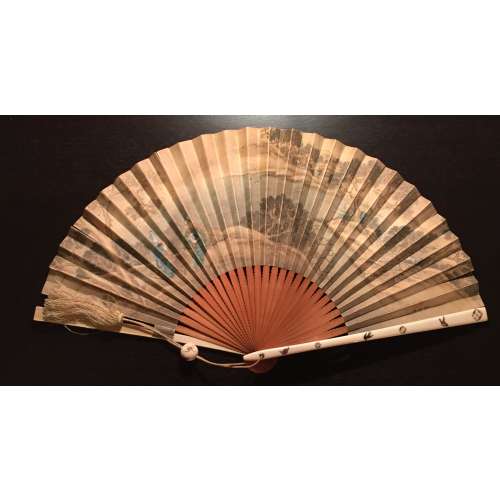 Late 19th-century (1850-1870) Japanese export fan. This fan has a double leaf painted with a different design on either side. Ivory encrusted with gemstones (birds and shippomon motif). Painting by ukiyo-e artist and printmaker Katsushika Isai (1821–1880) represents a riverside landscape with figures; birds and flowers on the reverse. Signed: Isai ga (為斎画) - "Painted by Isai".
Late 19th-century (1850-1870) Japanese export fan. This fan has a double leaf painted with a different design on either side. Ivory encrusted with gemstones (birds and shippomon motif). Painting by ukiyo-e artist and printmaker Katsushika Isai (1821–1880) represents a riverside landscape with figures; birds and flowers on the reverse. Signed: Isai ga (為斎画) - "Painted by Isai". -
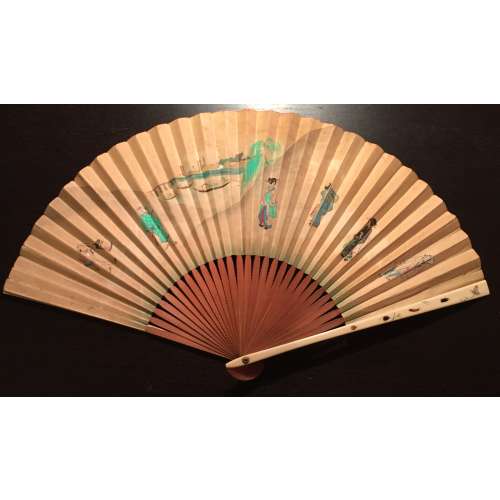 Late 19th-century (1850-1870) Japanese export fan. This fan has a double leaf painted with a different design on either side. Ivory encrusted with gemstones and other materials. Subject matter such as women wearing kimono is also more typical of export than domestic products (V&A). Summer (birds and flowers) theme on the reverse.
Late 19th-century (1850-1870) Japanese export fan. This fan has a double leaf painted with a different design on either side. Ivory encrusted with gemstones and other materials. Subject matter such as women wearing kimono is also more typical of export than domestic products (V&A). Summer (birds and flowers) theme on the reverse. -
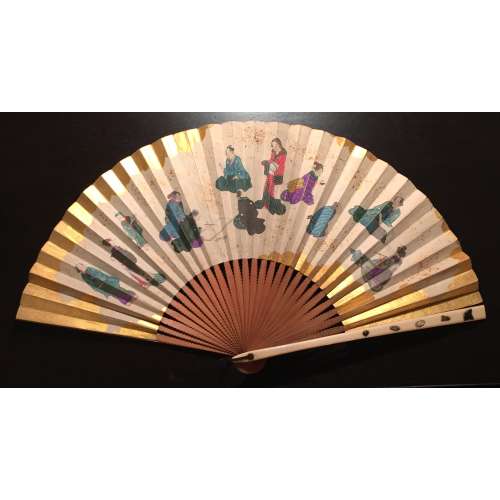 Late 19th-century (1850-1870) Japanese export fan. This fan has a double leaf painted with a different design on either side. Ivory encrusted with gemstones and other materials. Subject matter such as women wearing kimono is also more typical of export than domestic products (V&A). Autumn theme on the reverse.
Late 19th-century (1850-1870) Japanese export fan. This fan has a double leaf painted with a different design on either side. Ivory encrusted with gemstones and other materials. Subject matter such as women wearing kimono is also more typical of export than domestic products (V&A). Autumn theme on the reverse. -
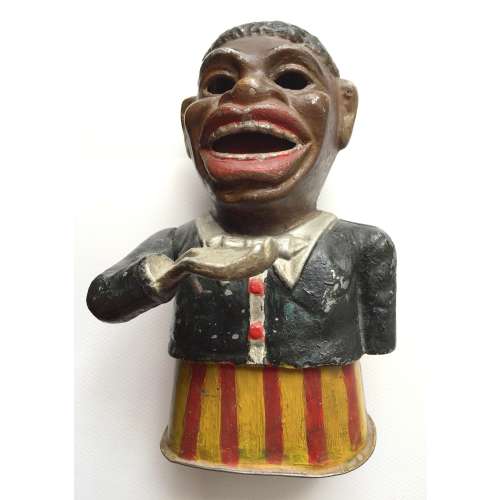 A cast iron painted 19th century style money box in the form of a negro, the arm articulated to insert coins.
A cast iron painted 19th century style money box in the form of a negro, the arm articulated to insert coins.


